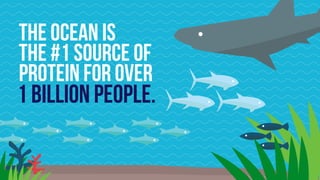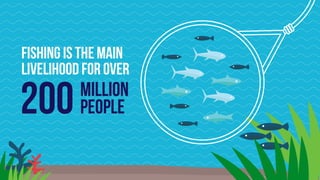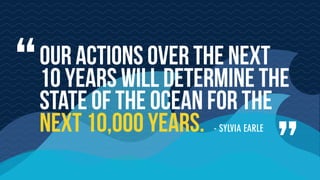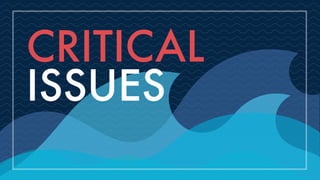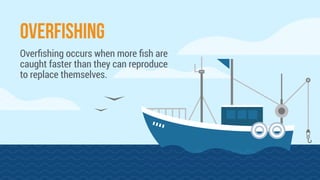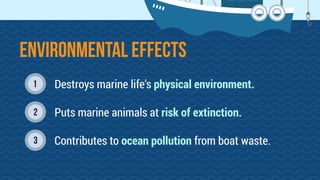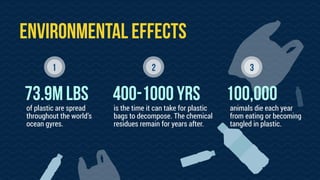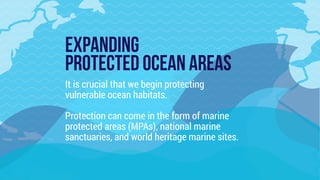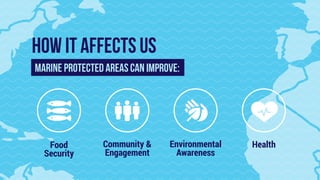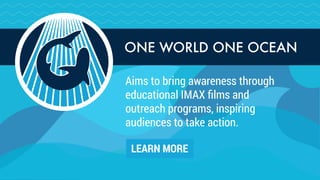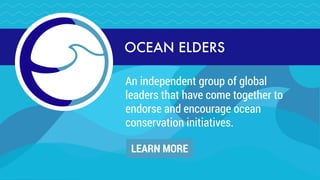The Global Ocean Crisis
- 2. The world’s oceans are home to an incredibly diverse array of life and are vital to human health, livelihood, and culture.
- 3. of our oxygen comes from the ocean. 50-70%
- 4. The ocean is the #1 source of protein for over 1 billion people.
- 5. Fishing is the MAIN livelihood for over 200people MILLION
- 6. Despite these rich benefits, oceans, marine wildlife, and their ecosystems continue to be damaged by human activities.
- 7. e.g. tuna, swordfish, halibut, cod, flounder 90% of big fish are gone due to overfishing.
- 8. Toxins from plastic degradation are eaten by marine animals and can lead to illness, death, or end up in our seafood.
- 9. Less than 2% of our oceans are protected even though the ocean accounts for 71% of the planet.
- 10. - SYLVIA EARLE “ ” Our actions over the next 10 years will determine the state of the ocean for the next 10,000 years.
- 11. CRITICAL ISSUES
- 12. OVERFISHING Overfishing occurs when fish are caught faster than they can reproduce to replace themselves.
- 13. Destroys marine life’s physical environment. Puts marine animals at risk of extinction. Contributes to ocean pollution from boat waste. 1 2 3 environmentAL EFFECTS
- 14. Increased cost of seafood and decreased variety. Loss of jobs in the fishing industry. Decreased tourism from loss of sea life and recreation. How it affects US
- 15. How WE CAN HELP Eat sustainably • Bluefin tuna • Chilean seabass • Imported shrimp • Orange roughy • Shark x Avoid:Fish Finder Fish 2 fork Online list and rating system for sustainable seafood by the Marine Conservation Society. Website dedicated to rating restaurants on their sustainable food options. LEARN MORE > LEARN MORE >
- 16. PLASTIC POLLUTION Massive amounts of plastic we use end up in the ocean. Plastic waste not only entangles and kills sea life but it also makes its way up the food chain until it ends up on our plate.
- 17. environmentAL EFFECTS animals die each year from eating or becoming tangled in plastic. 73.9M LBS of plastic are spread throughout the world’s ocean gyres. 400-1000 YRS is the time it can take for plastic bags to decompose. The chemical residues remain for years after. 100,000 1 2 3
- 18. HOW IT AFFECTS US Plastic toxins move up the food chain and end up on our plate. Damages our water systems leading to huge costs for taxpayers. Lost marine tourism from dirty beaches and oceans.
- 19. HOW WE CAN HELP Bring your own mug Refill a water bottle For less packagingInstead of using disposable cups DON’T BUY bottled water USE NON-PLASTIC CONTAINERS e.g. glass or paper Focus on reducing and reusing BUY IN BULK
- 20. EXPANDING PROTECTED OCEAN AREAS It is crucial that we begin protecting vulnerable ocean habitats. Protection can come in the form of marine protected areas (MPAs), national marine sanctuaries, and world heritage marine sites.
- 21. 64% of the ocean is not part of any nation’s jurisdiction and are vulnerable to overfishing and habitat destruction. 1000% is how much marine life can grow in mass when protected in marine reserves. 1 2 3 ENVIRONMENTAL EFFECTS 50% of Earth’s oxygen is provided by the ocean’s phytoplankton.
- 22. Food Security How IT AFFECTS us Community & Engagement Environmental Awareness Health marine protected areas can improve:
- 23. Make your voice heard How WE CAN HELP SPREAD THE NEWS Contact your local policy MAKER Forward this to a friend SHARE WHAT YOU LEARNED To reputable organizations DONATE YOUR TIME OR MONEY
- 25. OCEAN ELDERS An independent group of global leaders that have come together to endorse and encourage ocean conservation initiatives. LEARN MORE
- 26. ONE WORLD ONE OCEAN Aims to bring awareness through educational IMAX films and outreach programs, inspiring audiences to take action. LEARN MORE
- 27. THE TERRAMAR PROJECT A non-profit organization enabling citizens to come together as a community to protect the high seas. LEARN MORE
- 28. WWF Focuses on restoring and protecting marine ecosystems to support biodiversity, sustainable livelihoods, and economies. LEARN MORE
- 30. You might also want to check out: www.stinsondesign.com @stinsondesign 1.888.960.9851 SOURCES http://www.oneworldoneocean.com/pages/our-goals http://theterramarproject.org/#&panel2-1 http://www.oneworldoneocean.com/initiatives/PlasticsBreakdown http://www.oneworldoneocean.com/images/blog/ OWOO_PlasticsInfographic_2012_b.jpg http://5gyres.org/see_global_research/ http://www.oneworldoneocean.com/OWOO_KnowYourSeafood.jpg http://theterramarproject.org/education/problemsandsolutions http://www.oneworldoneocean.com/pages/why-the-ocean http://www.seaweb.org/resources/articles/writings/safina1.php https://www.worldwildlife.org/habitats/ocean-habitat http://www.marine-conservation.org/who-we-are/#mission http://overfishingdilemma.weebly.com/costs-of-overfishing.html http://www.unesco.org/new/en/natural-sciences/ioc-oceans/priority-areas/ rio-20-ocean/blueprint-for-the-future-we-want/marine-biodiversity/facts- and-figures-on-marine-biodiversity/



